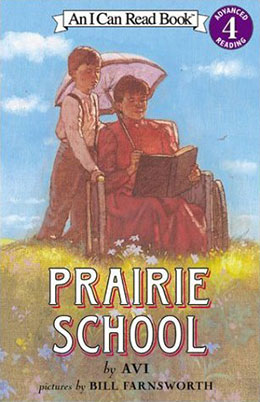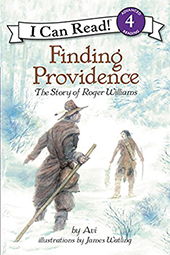Prairie School
What’s this book about?
It’s the 1880s. Noah works hard on the family farm and roams free on the Colorado prairie. One day his Aunt Dora arrives to give him some schooling. Noah doesn’t think he needs it. What use is reading on the prairie? But what Noah discovers will change his life forever.
Story Behind the Story
Other than my research there is no plan, no logic to my reading pleasure. I read what grabs my attention. So it was that I came upon a collection of reminiscences by folks from Nineteenth Century pioneer days, or at least homesteaders. I don’t know how the stories were gathered, but they were published, randomly, I believe, in newspapers. One of these tales concerned a young boy who lived on a prairie. He did not go to school and subsequently did not know how to read. But as he recalled he was taught to read by his visiting aunt, who was in a wheelchair.
Awards and Recognition
- Oppenheim Toy Portfolio Gold Award, 2004
Reviews
“This I Can Read Chapter Book is a good introduction to historical fiction. … Avi’s clear, simple language never sounds condescending, and the pictures show the tough kid’s bond with those who love him. The adults are a bit too nice and understanding, but new readers will enjoy both Noah’s rebellion and his awakening to the astonishing facts, stories, and poetry he can find in books.” (Booklist)
“Nine-year-old Noah loves living on the Colorado prairie in the 1880s where he helps his parents with all of the work. When Aunt Dora comes from the East to teach him how to read, he sees no need to do so and refuses to cooperate with her. However, his aunt refuses to give up. She asks Noah to show her the land even though he warns her that her wheelchair may make it difficult to get around. As he wheels her along, she consults the book in her lap and begins to tell him about the natural things around them. Impressed by her knowledge, the child decides to learn to read and write, and realizes that his aunt has opened a world beyond the prairies to him. Warm, soft-edged illustrations capture the intimacy of the loving family relationships and the vastness of the landscape on dark, starlit nights and glorious, sky-blue days. A combination of double-page spreads, full-page, and half-page illustrations appealingly reinforce the mood and action of the text. This gentle story with a great message that is nicely woven into the daily events would make a pleasant read-aloud as well as a good addition to easy chapter-book collections.”


